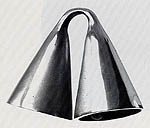|
|
 |
 ts powerful, penetrating sound made the bell a major means of communication
in many societies. It marked the hours of the day, signalled important events,
summoned people together, invoked the spirits, and punctuated rituals. It
also sounded warnings, repelled lightning, heralded births, and paid a final
tribute to the dead. The hand bells with clappers already in use in ancient
times were made of bronze or pottery.
ts powerful, penetrating sound made the bell a major means of communication
in many societies. It marked the hours of the day, signalled important events,
summoned people together, invoked the spirits, and punctuated rituals. It
also sounded warnings, repelled lightning, heralded births, and paid a final
tribute to the dead. The hand bells with clappers already in use in ancient
times were made of bronze or pottery.
| |

 Bell
Bell
By
Christina Kloepfer
Kitchener, Ontario
Circa 1983
Bronze
Overall width and height: 11 x 8.6 cm;
diameter of each
bell: 5 cm
Gift of the Massey Foundation
|
Opus 72 - Bell
| |

 Bell
Bell
By
Christina Kloepfer
Kitchener, Ontario
Circa 1983
Bronze
Diameter: 7.2 cm;
height: 7.5 cm
Gift of the Massey Foundation
|
Christina Kloepfer casts her bells in bronze. Opus 71 is similar in shape
to African double bells (which, however, are struck from the outside). Opus
72 has a more traditional shape.
Christina Kloepfer
Christina Kloepfer graduated from the Sheridan College School of Design in
1973. After apprenticing under sculptor Jordi Bonet in Montreal and
Frank Colson in Florida, she opened her own studio in 1978. Fascinated with
bronze, particularly its durability, she uses the lost-wax method of casting.
Through her work with metal, Kloepfer says she is carrying on a family tradition,
as her grandfather was a blacksmith.
For this artist, bell making combines two important elements: formal research,
which allows for artistic expression, and technical research (on the choice
of diameter, thickness, alloy and so on), which is reflected in utilitarian,
functional objects. The result is beauty of shape complemented by beauty
of sound. Christina Kloepfer's bells have been displayed in a number of
exhibitions across Canada. |





